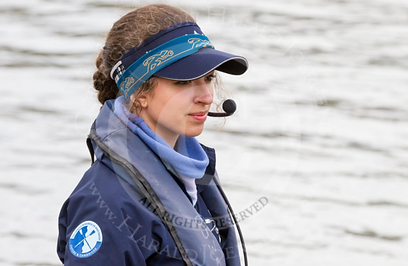
The cox (short for coxswain) is the brain of the boat, just as the rowers are the muscle. The cox is also the heart, inspiring that extra bit of determination and grit at the toughest curve in the race. Coxing takes equal parts insight, finesse, and mental toughness. Just as a rower is willing to push their burning legs even harder on a power 10, the cox puts aside his or her own mental and emotional fatigue to exude confidence and command respect from the crew.
Role of the cox
Fundamentally, the cox is responsible for a lot in the boat: steering, coaching, motivation, and safety.
- Steering: Much as a driver manipulates the accelerator, brakes, and steering wheel in a car, the cox manipulates the rowers and rudder to direct the boat. The cox starts and stops the boat with calls (“ready, go” and “easy there” respectively) and steers it using the rudder and differential pressure (“more power bow side”).
- Coaching: Though must outings have the advantage of experienced coaches on bicycles, the cox is in a unique position to see the rowers’ blades, feel the boat’s balance, and detect subtle cues in its motion that provide insight to the mechanics of the stroke. The cox is also positioned best to offer corrections while the boat is underway. Some outings have no bank rider, and the cox takes even more responsibility for coaching.
- Motivation: During a race as well as in training, the cox is responsible for keeping the morale of the crew strong. Finding just the right amount of enthusiasm — too little can be disheartening; too much can be draining — is critical. A good cox knows the rowers’ capabilities well, and can tell when they need to be pushed just a bit harder, and when they need to get off the water for a full English breakfast.
- Safety: The cox’s responsibility for safety is paramount. The cox coordinates all motions, from pre-outing stretches until the boat is safely returned to its rack. Novice crews especially will need guidance lifting and moving the boat, getting in and out, etc., safely. While advanced crews take care of these tasks themselves, the safety mission is never over. Even the strongest crew is at the mercy of the wind and stream, and other river traffic appearing out of place or manoeuvring unexpectedly. The cox is always on guard, adapting the outing plan to changing river conditions and keeping the rowers safe while they focus on rowing.
Advanced coxes also take on an administrative role for the boat. They are responsible for making sure boats are inspected before races, equipment is transported to regattas, the crew is obeying the rules of the river, and so on.
Novice Cox Training Plan

Balliol is lucky to have some extremely skilled coxes, but we are always looking for more! The high turnover inherent to a college club means that today’s novice coxes will be tomorrow’s experts, and everyone wants to share their expertise as widely as possible.
Unlike the strategy for training up a novice rower, a novice cox can’t just “jump in a boat” and see what happens: Until the cox knows the basics, nothing will happen at all. We’ve developed a programme to make it easy to know what to expect before you get into the cox’s seat:
- Before getting in the boat, you should aim to observe as many outings as necessary to get a feel for how an outing is run. You can observe any outing (novice or senior). You will ride your bicycle alongside the coach. The coach will answer questions you may have, but you are mostly there as an observer.
- It would also be helpful to attend at least one erg session, so you can practice timing your calls before getting on the water. Any crew would be happy to have you along for an erg, and most would let you practice making calls as well.
- If possible, please do attend a tank session. These are held sporadically throughout the year, especially in Michaelmas term. The tank is like a real boat, but it’s made of concrete and sits in a swimming pool. The tank is a great opportunity to practice without the distractions of a moving boat or other river traffic.
Once you are ready to cox, we will put you in the seat of a senior outing with an experienced cox/rower at stroke to guide you. Ideally, the captain of coxes will bank ride to help as well. This will mean that you are in good hands and have many experienced rowers and coxes surrounding you to help you on your way.
If you think coxing is for you and you want to get started, get in touch with our Captain of Coxes to get the ball rolling!
Experienced Coxes

If you already have some experience as a cox at Oxford or elsewhere, we are happy to get you into a Balliol outing without further ado. Simply contact our Captain of Coxes.
If your coxing experience is from outside of Oxford, you will unfortunately have to attend a brief (1-hour maximum) coxing meeting to be properly registered as an Oxford cox. The meeting will involve an explanation of the local rules of the river, and you will be allowed to leave before they go on to discuss which side of the boat is which.
If your coxing experience is from overseas, you’ll find a bit different terminology in England, but you’ll get used to it quickly. Instead of “port” and “starboard”, we say “stroke side” and “bow side”, respectively (yes, even if the stroke rower is on bow side). We have no clue what “weigh ’nuff” means, so we say “easy there”. We’re inclined to use “from backstops” or “from frontstops” rather than “at the finish” or “at the catch” when getting in position, but we understand both. Finally, we’re a bit obsessed with “go”, and almost all affirmative commands require it: “ready, go” replaces “ready, row”; and in general “next stroke, go!” replaces “in 2, in 1, on this one”.
Coxing Resources
Below, find links to a few useful coxing-related resources:
- Rachel Quarrell’s “Coxing for Beginners” – Rachel (known as RQ) is an icon in Oxford coxing, and manages much of the organising with OURCs. This is her guide for new Oxford coxes.
- OURCs Coxing Overview – the Oxford University Rowing Clubs (OURCs) is the oversight body for collegiate rowing in Oxford. This is their coxing overview page.
- OURCs Coxing Frequently Asked Questions – This is OURCs’ page answering a lot of questions specific to Oxford coxing, including flag rules and status upgrades.
- OURCs Coxing Competencies – This is OURCs’ page detailing the expectations before being promoted to an experienced (X) level cox.
